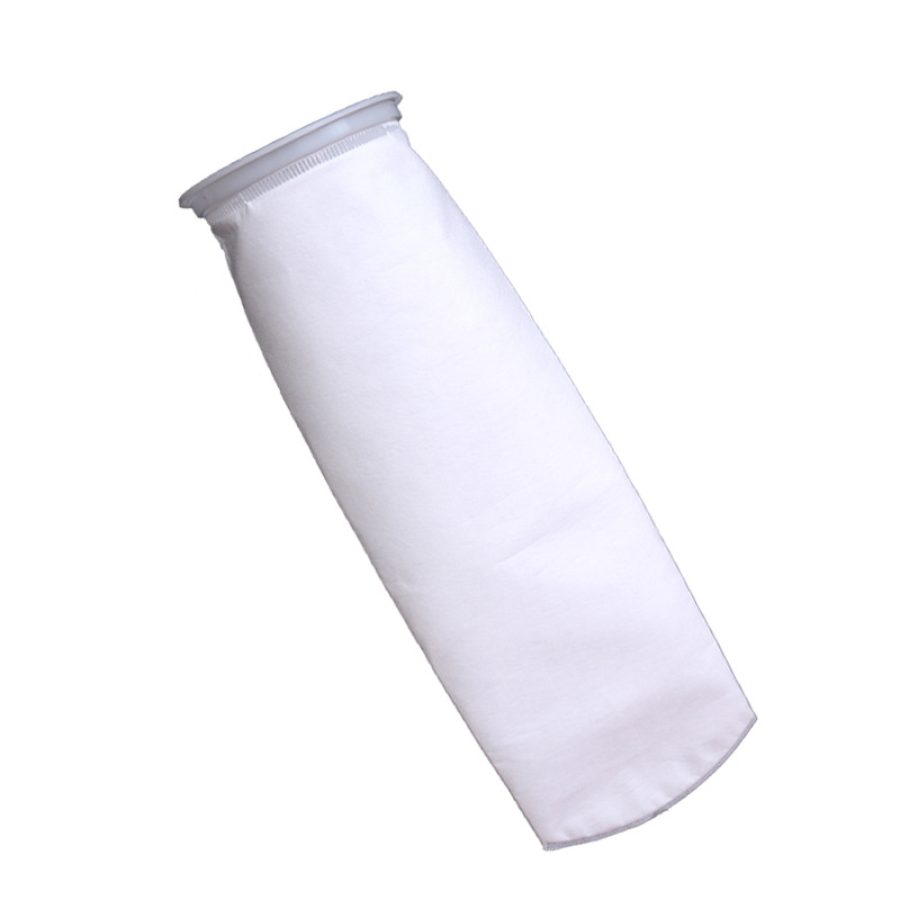

Polyester (PE) Filter Bags
Key Features
- Advanced 5-line needle construction for enhanced sealing
- Heat-treated finish for improved durability
- Superior resistance to:
- Abrasion
- Acids
- Alkaline solutions - Temperature resistance: -20°C to 130°C
- Available with plastic or steel rings for optimal sealing
- High dirt-holding capacity
- Excellent chemical compatibility
Technical Specifications
| Model | Diameter (inch) | Length (inch) | Volume (L) | Precision (Mesh) | Max Flow Rate (m³/h) | Filtration Area (m²) | |||||||||||||||||||||
|---|---|---|---|---|---|---|---|---|---|---|---|---|---|---|---|---|---|---|---|---|---|---|---|---|---|---|---|
| Size #1 | 7.09 | 16.93 | 8 | 0.1, 0.5, 1, 5, 10, 25, 50, 100, 150, 200, 300, 500 | 20 | 0.25 | |||||||||||||||||||||
| Size #2 | 7.09 | 31.89 | 17 | 0.1, 0.5, 1, 5, 10, 25, 50, 100, 150, 200, 300, 500 | 40 | 0.5 | |||||||||||||||||||||
| Size #3 | 4.13 | 9.06 | 1.3 | 0.1, 0.5, 1, 5, 10, 25, 50, 100, 150, 200, 300, 500 | 6 | 0.09 | |||||||||||||||||||||
| Size #4 | 4.13 | 14.96 | 2.5 | 0.1, 0.5, 1, 5, 10, 25, 50, 100, 150, 200, 300, 500 | 12 | 0.16 | |||||||||||||||||||||
| Size #5 | 5.91 | 21.65 | 7 | 0.1, 0.5, 1, 5, 10, 25, 50, 100, 150, 200, 300, 500 | 18 | 0.3 | |||||||||||||||||||||
Need Polyester Filter Bags for Your Process?
From standard sizes to custom requirements
Polyester (PE) Filter Bags: Industrial-Grade Filtration Solutions
- Operating range: -4°F to 266°F (-20°C to 130°C)
- Consistent filtration efficiency across temperature range
- Suitable for elevated temperature applications

- 5-line needle stitched design with thermal treatment
- Reliable sealing characteristics
- Structured for operational stability
- Effective performance under standard pressure conditions

- 5 standard size options
- Flow rates up to 40 m³/h (Size #2)
- Maximum filtration area of 0.5 m²
- Optimized dimensions for efficient operation

- Micron ratings from 0.1 to 500 μm
- Reliable particle retention
- Maintains specified flow rates
- Adaptable to multi-stage filtration requirements

- Tested compatibility with acids and alkalis
- Abrasion resistant construction
- Verified performance in chemical processes
- Low fiber release characteristics

Industry Applications
FAQs
How do I choose the right filter bag for my application?
Consider these factors:
- Process fluid characteristics
- Operating temperature range (-4°F to 266°F)
- Required filtration level (0.1-500 μm)
- Flow rate requirements
- Chemical compatibility
- Housing specifications
- Pressure conditions
- Regulatory requirements
What makes the 5-line needle stitched construction superior?
Benefits include:
- Enhanced sealing efficiency
- Better pressure handling
- Reduced risk of bypass
- Improved structural integrity
- Extended service life
- Consistent performance under varying conditions
What factors affect filtration efficiency?
Key factors include:
- Particle size distribution
- Flow rate
- Fluid viscosity
- Temperature
- Pressure differential
- Contamination level
- Maintenance practices
- Filter media condition
How do I optimize filter bag performance?
Best practices include:
- Regular monitoring of pressure differential
- Proper installation procedures
- Adherence to flow rate specifications
- Regular maintenance schedule
- Correct housing installation
- Proper venting procedures
- Clean changeout practices
What are the signs that a filter bag needs replacement?
Monitor these indicators:
- Increased pressure differential
- Reduced flow rate
- Breakthrough of contaminants
- Visual inspection results
- Operating time limits
- Process quality changes
- Regulatory requirements
What's the proper storage procedure for unused filter bags?
Recommended storage conditions:
- Clean, dry environment
- Room temperature
- Away from direct sunlight
- Original packaging
- Protection from moisture
- Avoid chemical exposure
- Regular inventory rotation
What chemical compatibility factors should I consider?
A: Important considerations:
- Process fluid composition
- Operating pH range
- Chemical concentration levels
- Temperature effects on compatibility
- Expected exposure duration
- Cleaning chemical compatibility
- Material degradation risks
How does temperature affect filter performance?
Temperature impacts:
- Material strength
- Sealing effectiveness
- Flow characteristics
- Chemical resistance
- Service life
- Filtration efficiency
- Pressure handling capability
What are the proper installation procedures?
Key steps include:
- Clean housing inspection
- Proper ring seating
- Correct orientation
- Proper venting
- Secure closure
- Leak checking
- System pressure testing
How can I maximize cost-effectiveness?
Optimization strategies:
- Proper size selection
- Correct micron rating choice
- Regular maintenance
- Optimal changeout timing
- Process optimization
- Proper handling procedures
- Quality monitoring
What are special considerations for food & beverage applications?
- FDA compliance requirements
- Sanitary handling procedures
- Documentation needs
- Cleaning protocols
- Material certification
- Change-out frequency
- Quality control measures
How do different industries typically use these filters?
Industry-specific applications:
- Water Treatment: Pre-filtration, processed water
- Chemical: Product filtration, catalyst recovery
- Food & Beverage: Final product filtration
- Industrial: Process fluid cleanup
- Automotive: Paint filtration, coolants
- Electronics: High-purity water filtration












